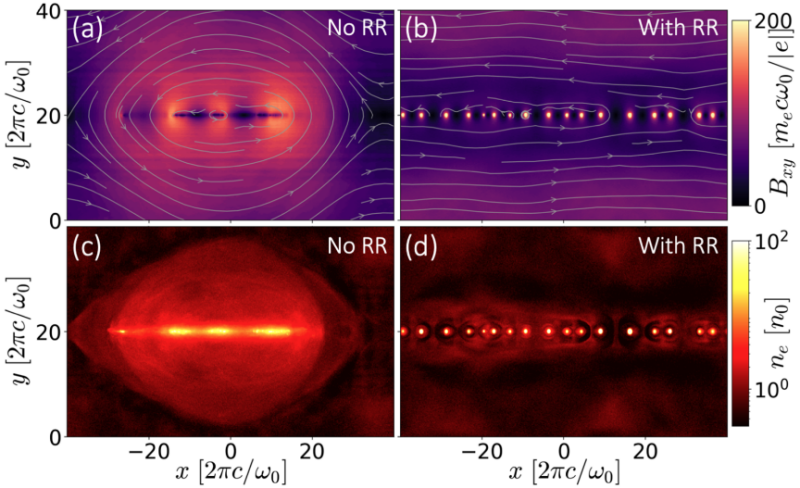Research Progress
Spin-Polarized Condensed Plasmoids in Radiation Reaction Dominated Magnetic Reconnection
Magnetic reconnection is a key process in plasma physics that enables the rapid conversion of magnetic energy into plasma heating and particle acceleration. It occurs widely in various astrophysical and laboratory plasma environments, including solar flares, Earth’s magnetotail, black hole jets, gamma-ray bursts, and fusion devices. When the magnetic field strength reaches extreme values (around 10¹⁰G), electrons undergoing reconnection inevitably enter a radiation reaction-dominated regime, where radiation damping, high-energy photon emission, and spin dynamics play critical roles in determining plasma behavior. However, how plasmas evolve under such extreme conditions, how electron spin responds, and how radiation signatures emerge remain open questions at the forefront of plasma physics and high-energy astrophysics.
Recently, Prof. Dr. Zheng Gong from the Institute of Theoretical Physics, Chinese Academy of Sciences, in collaboration with Dr. Karen Hatsagortsyan and Prof. Dr. Christoph Keitel from the Max Planck Institute for Nuclear Physics in Germany, reported significant progress in this direction. Using a particle-in-cell simulation framework that incorporates radiation reaction, spin dynamics, and quantum polarization effects, the research team has, for the first time, discovered a novel feature in radiation-dominated magnetic reconnection: spin-polarized condensed plasmoids [see Fig. 1]. The study shows that electrons in the reconnection layer rapidly contract in phase space toward a spiral attractor—a fixed point induced by radiation damping—where they form multiple compact, high-density plasmoids while simultaneously achieving quasi-synchronous spin polarization aligned with the local magnetic field.
This condensed structure not only exhibits a much higher density compression ratio than traditional plasmoids, but more strikingly, the emitted high-energy gamma-ray photons display an anomalous linear polarization, with polarization vectors oriented perpendicular to the electron motion plane. This observation deviates significantly from predictions of classical synchrotron radiation models. It reveals that spin-flip transitions play a crucial role in the radiation process by altering the exchange of angular momentum and reshaping the resulting polarization patterns. This finding offers a new theoretical basis for interpreting anomalous gamma-ray polarization signals observed from high-energy astrophysical sources such as magnetars and the Crab Nebula.
The study further suggests that such spin-polarized condensed plasmoids may be realized in state-of-the-art high-power laser experiments. Facilities like ELI and SULF are capable of recreating similar extreme reconnection conditions via laser-plasma interactions. Moreover, the underlying mechanism is likely relevant to astrophysical systems such as magnetar magnetospheres and gamma-ray burst jets, where strong magnetic fields naturally arise. The highly polarized gamma photons emitted from these regions could be detected by next-generation polarization-sensitive space telescopes.
This research systematically incorporates radiation reaction and spin dynamics into the modeling framework of extreme magnetic reconnection, overcoming previous approximations that neglected spin-related radiation effects. The newly revealed spin-polarization–radiation-polarization connection opens a promising observational window in multi-messenger high-energy astrophysics, providing a novel diagnostic tool for probing magnetic field structures, particle acceleration mechanisms, and local plasma states in extreme environments.
The study has been published online in Physical Review Letters under the title "Spin-Polarized Condensed Plasmoids in Radiation Reaction Dominated Magnetic Reconnection". https://journals.aps.org/prl/abstract/10.1103/c1pk-jmqr. This work was supported by the National Natural Science Foundation of China (Grant No. 12447101) and was conducted using the high-performance computing resources at ITP-CAS.

Fig. 1: The snapshots of (a)(b) magnetic field and (c)(d) electron density for the case (b)(d) with and (a)(c) without RR, respectively, where the gray arrows denote the magnetic direction.
